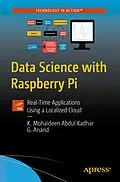Implement real-time data processing applications on the Raspberry Pi. This book uniquely helps you work with data science concepts as part of real-time applications using the Raspberry Pi as a localized cloud.
You'll start with a brief introduction to data science followed by a dedicated look at the fundamental concepts of Python programming. Here you'll install the software needed for Python programming on the Pi, and then review the various data types and modules available. The next steps are to set up your Pis for gathering real-time data and incorporate the basic operations of data science related to real-time applications. You'll then combine all these new skills to work with machine learning concepts that will enable your Raspberry Pi to learn from the data it gathers. Case studies round out the book to give you an idea of the range of domains where these concepts can be applied.
By the end of Data Science with the Raspberry Pi, you'll understand that many applications are now dependent upon cloud computing. As Raspberry Pis are cheap, it is easy to use a number of them closer to the sensors gathering the data and restrict the analytics closer to the edge. You'll find that not only is the Pi an easy entry point to data science, it also provides an elegant solution to cloud computing limitations through localized deployment.
You will:
- Interface the Raspberry Pi with sensors
- Set up the Raspberry Pi as a localized cloud
- Tackle data science concepts with Python on the Pi
Autorentext
Dr. K. Mohaideen Abdul Kadhar has an undergraduate degree in electronics and communication engineering and an MTech with a specialization in control and instrumentation. In 2015, he obtained his PhD in control system design using evolutionary algorithms. He has more than 14 years of experience in teaching and research. His area of interest is implementing signal processing and control system concepts with Python programming on the Raspberry Pi. He has conducted many courses and delivered workshops in data science with Python programming. He has also acted as consultant for many industries in developing machine vision systems for industrial applications.
Klappentext
Implement real-time data processing applications on the Raspberry Pi. This book uniquely helps you work with data science concepts as part of real-time applications using the Raspberry Pi as a localized cloud.
You'll start with a brief introduction to data science followed by a dedicated look at the fundamental concepts of Python programming. Here you'll install the software needed for Python programming on the Pi, and then review the various data types and modules available. The next steps are to set up your Pis for gathering real-time data and incorporate the basic operations of data science related to real-time applications. You'll then combine all these new skills to work with machine learning concepts that will enable your Raspberry Pi to learn from the data it gathers. Case studies round out the book to give you an idea of the range of domains where these concepts can be applied.
By the end of Data Science with the Raspberry Pi, you'll understand that many applications are now dependent upon cloud computing. As Raspberry Pis are cheap, it is easy to use a number of them closer to the sensors gathering the data and restrict the analytics closer to the edge. You'll find that not only is the Pi an easy entry point to data science, it also provides an elegant solution to cloud computing limitations through localized deployment.
You will:
- Interface the Raspberry Pi with sensors
- Set up the Raspberry Pi as a localized cloud
- Tackle data science concepts with Python on the Pi
Inhalt
Chapter 1: Introduction to Data science
- What is data?
- Data Science: An overview
- Recent trends in data science
Chapter 2: Basics of Python Programming
- Why Python?
- Python versions and installation
- Python IDEs
- Python data types
- Functions
- Python modules
- Exceptions
- Python packages for data science
Chapter 3: Introduction to Raspberry Pi
- Raspberry Pi Hardware
- Raspberry Pi Versions
- Setting up the Raspberry Pi
- Interfacing Raspberry Pi with sensors
- Raspberry Pi as an edge device
- Raspberry Pi as localized cloud
Chapter 4: Gathering Real-Time Data Using the Raspberry Pi
- Sensors and signals
- Data acquisition
- Data transfer- Time series data
- Memory requirements
Case study: Gathering real-time industry data
Chapter 5: Preparing the Data
- Structuring the real-time data into CSV format
- Structuring the real-time data into XML format
- Pandas data structures
- Series
- Data Frame
- Panel
- Cleaning the data
- Handling missing values
- Handling outliers
- Filtering inappropriate values
&a...
